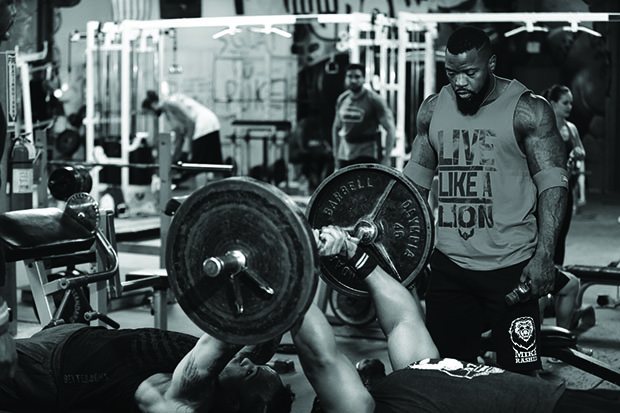Q: What type of strength training would you do for mixed martial arts?
A: That could be the subject of an entire book, but I’ll give the overall picture so you can get started. Here’s how I’d steer the training process:
1) Get a structural balance evaluation, as described in the level 1 and 2 practical portions of the Poliquin International Certification Program. That will identify priorities in training. To find a certified strength coach in your area, go to my Web site, www.CharlesPoliquin.com.
2) Get an overall view of the different types of training, and rate them on a scale of 1 to 10 on their bioenergetics. For example, grappling training is far more demanding than boxing. That will help you decide how to organize your weekly training schedule.
3) Schedule strength-training sessions based on overall training demands. High-threshold motor units should be trained first during the day. So, for example, you would do Olympic lifts in the morning and mat work in the evening.
4) There are many ways to schedule the strength training. I think for most MMA athletes the best approach is five days a week with only two exercises per session. For example, alternate thick-handle neutral-grip pullups with standing one-arm thick-dumbbell overhead presses.
5) Training for relative strength should be your primary concern, unless you’re asked to move up a weight class. Then functional hypertrophy becomes the quality to train.
6) Do thick-bar work when you train your upper body; that will ensure that the strength you build in the gym transfers to the mat.
7) Finish each session with forearm and grip work. Make sure you vary it a lot: gripping, radial flexion, ulnar flexion, etc.
By following those guidelines, you should derive the maximum benefit from strength training for the mixed martial arts.
Q: Where do you get your workout stuff? Is it all yours?
A: No, not at all. I’ve had many mentors who taught me very effective training methodology, either through their writings or through private teaching sessions. Long before the use of anabolic steroids became a common shortcut in the iron game, legendary Canadian strongman Doug Hepburn was clearly demonstrating that the optimal mix of principle-based training, nutrition, adequate recovery and drive can help you achieve Herculean levels of strength. For example:
1) Concentrate on two lifts per day. The analogy that Steven Covey uses in his book First Things First is, put the big rocks in the jar first. If you get strong on two basic lifts per workout, plenty of strength gains will follow. As often as permissible, I set up antagonistic pairs together, such as pullups and overhead presses. All the exercises Hepburn recommended were most-bang-for-your-buck moves, such as deadlifts, squats and presses. No triceps kickbacks here.
2) Do lots of sets for maximum strength. Do only a few things, but do them extremely well. Ask any real expert on strength training; it’s a very basic principle.
Two years ago I gave an invitation-only sport-specific strength-training program at Level 5 PICP coach Roberto Sabatini’s gym in Quebec, and I had Pierre Roy, the best lifting coach in North America, give a guest lecture. Dr. Espen Artzen, Norway’s first Level 4 PICP coach, asked Pierre, “What are the three most important keys to success in strength training?” Pierre’s answer was as follows: One, hard work; two, hard work; three, hard work. The strongest always have the biggest work capacity.
If you ever have a chance to look into the details of Doug Hepburn’s methodology for increasing maximum strength, you’ll see that it’s centered on lots of basic work.
3) Excite the nervous system first, and then do functional hypertrophy. Many of my successful colleagues use a variation of that approach.
Using Hepburn’s methodology and adding some refinements, such as exact prescriptions for exercise tempo and rest intervals, you could do a torso workout like the sample in the box below left. A sample lower-body workout appears above.
4) Use split routines. I used to find that total-body workouts were just too draining to recover from. I started to make progress myself only when I split my training up following Doug Hepburn’s or Anthony Dittilo’s methods. Oddly enough, “strength journalists” are pushing for total-body training. If you get to meet those who write that, however, you’ll discover that their best bodypart is greasy hair.
I was able to train a host of Olympic medalists by using two key lifts per day, multiple training sessions per week. Whether it was Adam Nelson or Pierre Lueders, they all used split routines. What I added to the fundamentals of the Hepburn system were standardized rest intervals and tempo—making it even better.
My colleague Christian Thibaudeau is probably one of the few Internet writers to sport a physique with strength to match—and he is a split-routine user. Success leaves clues.
5) Take your time. Doug Hepburn preached taking your time to adjust the load upward, which is something I strongly endorsed. Pierre Roy taught me the same thing. Want to increase your squat? Take a weight that will have your spleen coming out of your left eye socket on eight sets of two. Then at every successive workout try to add one rep per set to one set. Once you can complete 8 x 3, then it’s time to increase the weight.
The human body has not dramatically evolved in the last 50 years. Basic hard work still prevails. There are no shortcuts.
Editor’s note: Charles Poliquin is recognized as one of the world’s most suc-cessful strength coaches, having coached Olympic med-alists in 12 different sports, including the U.S. women’s track-and-field team for the 2000 Olympics. He’s spent years researching European journals (he’s fluent in English, French and German) and speaking with other coaches and scientists in his quest to optimize training methods. For more on his books, seminars and methods, visit www.CharlesPoliquin.net. Also, see his ad on page 193. IM













You must be logged in to post a comment Login